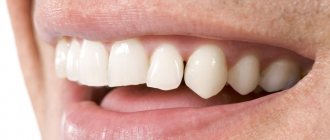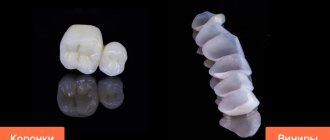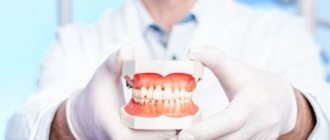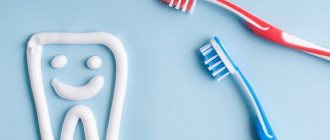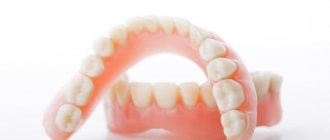What is a pin
In modern dentistry, various designs are used to recreate damaged teeth.
A pin is one such structure that serves as a support for filling material or a crown. The pin is installed in the root cavity after the nerve is removed. Thanks to this procedure, it is possible to preserve the root, dentition and original structure of the jaw.
The main task of the pin, which is installed on a pulpless tooth, is to evenly distribute chewing pressure. Thus, when chewing, parts of the restored tooth will not experience increased pressure and will not be damaged.
General overview
From a technical point of view, we are talking about one of the varieties of prosthetic products designed to replace dental tissue that has been removed or lost due to pathological changes. Installing a crown on a pin is a common procedure that is a worthy alternative to other orthopedic options. In addition to the main part, which is responsible for the aesthetic appearance of the row and functional operation, the structure is equipped with a fastening in the shape of a cone or cylinder, with which the crown is attached to the preserved root part.
Tooth restoration using a pin: indications and contraindications
If a tooth can be saved, then it is worth fighting for. You can always make it in time with dentures or implantation, but time is running out to save your natural tooth. In this regard, it is important to seek dental care in a timely manner. Let's consider cases when the extension procedure is appropriate and when it is not.
Indications
- Cases when the tooth is destroyed by half or more, but the root is intact. Even if the crown is destroyed, but the root is intact, then extension onto a pin is possible.
- Damage in which the degree of dentin damage does not allow filling. For restoration work, a support in the form of a pin is required to minimize and distribute the chewing load.
- Cases when a tooth needs to be restored for further dental prosthetics. In this case, the restoration is carried out with the aim of using the tooth as a support for the prosthesis.
Contraindications
- The roots of the teeth are destroyed. In this case, there is no stable support for the pin, and installing the structure is risky.
- Inflammatory diseases of the oral cavity. In particular, we are talking about inflammatory pathologies of the gums (gingivitis, periodontitis).
- Cysts, granulomas or tumors in the area of the tooth to be restored.
- Thinning of the walls of the root canals. If during diagnostics it is clear that the wall thickness is 2 mm or less, then pin restoration is not performed.
Alternative options
If tooth augmentation is contraindicated for a patient, this does not mean that a beautiful smile can be given up. Dentistry offers a number of alternative methods, among which the following are often used:
- Implantation – installation of an implant on the jaw bone. Then an abutment and crown are installed on the healed implant. The Center for Israeli Dentistry performs all types of implantation - one-stage, two-stage, All-on-6 and All-on-4 implantations.
- Installation of dental inlays is a microprosthetic option often used to restore lateral teeth. Often such inlays are used for advanced stages of caries or injuries. The production of the inlay is carried out by a dental technician, who makes the design based on a computer model of the patient’s dentition.
- Metal-ceramic crowns are a metal dental prosthesis coated with ceramics. The advantage of metal ceramics is strength, durability (up to 12 years) and aesthetics.
Alternative options for dental restoration are discussed with your doctor. The dentist will recommend the best option based on medical indications, patient preferences, and financial capabilities.
Stages of the procedure
Veneering improves the visual characteristics of the incisors that form the smile area. Ceramic microprostheses not only protect teeth from injury and the negative influence of external factors, but also help eliminate psychological complexes that interfere with full communication with others, arising from a feeling of embarrassment from existing defects. When preparing for prosthetics, it is important to strictly follow existing medical protocols and recommendations - this guarantees a successful outcome of aesthetic restoration.
The sequence of turning for ceramic veneers
The preparatory stage algorithm includes two stages - treatment of the vestibular surface and lateral areas (required), as well as cutting edges and adjacent tissues (optional, if necessary).
First, the doctor must determine the thickness of the enamel layer to be removed. The indicator is calculated based on two factors - the type of onlays planned for use, as well as the condition of the dental crowns to be restored.
During contour processing, it is possible to maintain the natural occlusion, or to correct adjacent contact lines as necessary to give the correct shape. Under certain conditions, taking into account both the features of the model and the configuration of the microprosthesis, the cutting edge of the unit can either be ground or left in its original form.
Teeth cut down to install veneers are re-treated before the final phase to improve adhesion. The importance of competent preparation is especially emphasized by specialists, since insufficient attention to mandatory procedures not only negates all efforts and intermediate results of prosthetics, but can also have a negative impact on the condition of the maxillary region as a whole.
What types of structures are there?
Pins differ depending on the material and type of thread. Let's look at the most popular types of structures used in dentistry:
- Anchor - made of an alloy of gold and platinum or palladium metal. There are active and passive anchor pins. In the first case, the design has a thread, in the second - without thread. The anchor pin is a rod, which is fixed in the root canal. This design provides support for both the microprosthesis and the filling. The advantage of an anchor pin is that it allows you to restore even a severely damaged tooth.
- Titanium – rod structure made of high-strength titanium alloy. This design is fixed in the root canal, often in chewing teeth, since it can withstand heavy loads. Titanium structures are suitable for bulk fillings and even prostheses.
- Fiberglass – Made from high-strength fiberglass. In terms of physical characteristics, glass fiber has similar properties to dentin tissue. Thus, when restoring with a fiberglass pin, the load on the tooth is distributed evenly. Fiberglass is used in medical practice due to its hypoallergenicity and biocompatibility. Another advantage of fiberglass is color. Such structures are colorless or resemble enamel, which is why they are also installed on the front teeth.
- Carbon fiber is the most popular type used in orthopedic dentistry. In structure and physical properties, carbon fiber structures resemble bone tissue. Such pins are characterized by both high strength and elasticity. When installing carbon fiber structures, the likelihood of root and crown fractures is minimized.
- Parapulpal - made of an alloy with stainless metal. Parapulpal structures are rarely used today. They are often installed as additional support for a filling.
Pin structures are also distinguished by shape. Based on this feature, screw, cylindrical, cylindrical-conical and conical structures are distinguished. The shape of the structure is selected depending on the structure of the root canal and the characteristics of the planned treatment.
Roll pins are used when the root strength is sufficient. They provide the patient with sufficient retention. In addition, when selecting, it is important to take into account the diameter. If the diameter of the rod is too small, then during restoration work a gap may form, which can cause the filling to become brittle and lead to infection. If the diameter is too large, there is a risk of root damage.
As for conical forms, when using such structures the risk of root damage is minimal. However, with conical pins, a wedging effect is possible during chewing.
Methods for installing veneers
Based on which protocol turned out to be more preferable for preparation, the order in which microprostheses will be installed is determined. There are also two possible options here.
Single
Point placement of ceramic or zirconium plates on a previously prepared surface, with control of the position relative to the center, as well as checking the strength and tightness of the fit.
Plural
When performing sequential prosthetics of the frontal region, adjacent onlays must be in harmonious contact with each other, leaving no cracks or gaps. Modern digital image processing technologies make it possible to visualize the future result even at the planning stage, thanks to which the patient can immediately evaluate the aesthetics of the appearance, choose the appropriate shade, and also make adjustments that are appropriate, from his point of view.
How a tooth is restored: stages of treatment
The extension procedure on a pin takes place in several stages:
- Diagnostics . Before starting the procedure, a thorough study is carried out. The patient undergoes a three-dimensional computed tomography and orthopantomogram of the jaw. It is important to consider in detail how damaged the tooth is in order to select the necessary pin and method of restoration.
- Taking impressions . To carry out restoration work, impressions are first taken. This procedure is performed if the patient has a crown installed. It is important that the crown fits anatomically into the dentition without causing discomfort to the patient.
- Bone grafting . Some patients undergo bone grafting before the augmentation procedure. This is necessary for bone deficiency.
- Installation of the pin . A pin is installed in the root. It is fixed with cement or screwed in (if the pin is active, threaded).
- Filling . The free space in the pin area is filled with composite material.
- Restoration . The final part of the procedure is when the tooth is restored. The doctor uses a durable filling material to recreate the coronal part. The restoration is carried out using a high-strength photopolymer that will last the patient up to 10 years. Now the restored part has a double support - the root and an installed pin that can withstand the loads on the tooth.
If the patient decides to undergo prosthetics, a crown is installed on the pin. Initially, a temporary crown is placed on the post. The patient stays with it until the dental technician makes a metal-ceramic crown based on the impression. The patient is then fitted with a permanent crown, secured with cement. In the future, work on polishing and correction of the permanent crown is possible.
Restoration of teeth using cast core inlays
This is one of the most reliable and proven methods of restoring a tooth stump.
A cast stump inlay is essentially an individual pin cast from metal, strengthened in the tooth canal with cement, and restoring the supragingival part of the tooth.
This is a monolithic structure without seams or joints, and therefore very durable and resistant to significant loads. Do you still have questions about restoring a damaged tooth using a therapeutic method? Get a free consultation from specialists. Registration is open online on the clinic website!
Possible complications
Every medical procedure has a risk of complications. In this case, when a pin is installed on a tooth, in rare cases the following complications arise:
- Toothache . This symptom after dental procedures is normal. To relieve pain, the doctor will prescribe medications for toothache. In most cases, pain bothers you for the first 2-4 days. If the pain does not subside within this time, consult a doctor. There may be an inflammatory process in the oral cavity caused by the tooth extension procedure.
- Root fracture . When a tooth is built onto a post, there is a risk of root fracture. The likelihood of such a complication is minimal, but it should not be excluded. Often the root is affected during the procedure when installing active anchor structures with threads.
- Chips and cracks . A pin is placed on the tooth to reduce and evenly distribute the load during chewing. Sometimes the tooth cracks or chips, unable to withstand the chewing load.
Pros and cons of installing prosthetics with pins
Disputes about the advantages and disadvantages of dental prosthetics using pins can often be heard in dental offices. Sometimes there are quite convincing arguments that have no serious justification. Therefore, we bring to your attention a list of the real advantages of this method of prosthetics:
- it is possible to save a damaged tooth;
- loads are distributed not along the upper plane of the tooth, but along the entire length of the root;
- using aesthetic pins, dentin and enamel can be restored;
- a way to build up or lengthen a dental stump for subsequent installation of a ceramic crown.
This procedure also has its disadvantages. They can also be expressed as a corresponding list:
- high risk of root splitting;
- the difficulty of subsequently removing the pins from the root;
- If the tightness of the structure is violated, the likelihood of caries increases sharply.
Even if the pinning was successful, the patient continues to be observed by a doctor in order to promptly identify and stop some unwanted complications. This procedure can cause perforation, granuloma, swelling of the gums, or pain when pressing on the tooth. If these symptoms occur, you should immediately contact your dentist.
Service life and warranty
First of all, you need to understand that guarantees for dental prosthetics and the service life of denture structures are different concepts. And if the clinic provided the patient with a guarantee for 2 years, this does not mean that after this period the prosthesis will have to be changed. The operating time of a prosthetic structure (that is, its service life) is usually much longer than the official guarantee, so the patient should not be afraid that the installed prostheses will only “last” for a year or two, and then they will have to undergo treatment again.
Possible contraindications
Augmentation is a fairly new technology that allows you to completely restore a lost tooth. It is not as painful as other methods, and allows you to save the tooth, even if there is only one root left.
Damaged teeth are not only a cosmetic problem, but also an excellent environment for the development of infectious diseases. The cause of injury may be temporary wear, chips, cracks or carious processes. All of these are indications for the procedure.
A contraindication to extensions is the presence of an allergy to the materials used for manipulation. It is also recommended to refuse the procedure in case of severe pathologies of the oral cavity and dysfunction of the temporomandibular joint. Some techniques have their own contraindications, of which the doctor must notify the patient.
Before and after extensions
Previously, implants were used for restoration, but thanks to modern advances, doctors can build up damaged areas of tissue. The following types of recovery exist:
- extension with composite materials;
- filling;
- pin restoration;
- installation of veneers or lumineers;
- crown covering.
Ceramic veneers: patient reviews
Patient reviews of ceramic veneers in most cases are enthusiastic, because they really can make you the owner of a Hollywood smile. But, this is only if your veneers are done by a truly highly qualified dental technician. In addition, it is very important that the clinic you go to has its own dental laboratory.
This will allow the prosthodontist and dental technician to make decisions together while standing at the chair, and the dental technician will then have the opportunity to look at you in the chair, allowing him to select the best color and translucency option for your veneers.
Advantages of ceramic veneers –
- Highest aesthetics.
- Complete color stability - they do not darken or fade over time, as happens with composite veneers.
- High reliability - service life is limited only by extreme circumstances, such as injury, and ranges from 12 to 25 years in most cases.
The only drawback of such veneers is their cost. But a natural question arises: how can veneers made from a thin layer of porcelain 0.3-0.5 mm thick be strong at all? There are not many clinical studies in the world on the strength of veneers and their service life. However, we tried to find them (you can see the results below).
- The results of the study (author - Smales, 2004) - the “survival rate” of veneers 7 years after their manufacture was: after 7 years, 86% of veneers made without overlapping the incisal edge functioned perfectly, and their owners had no complaints about them .
However, for veneers made with incisal overlap, the survival rate was 96%. This suggests that, firstly, ceramic veneers with an overlapping incisal edge are more reliable, and secondly, that after 7 years only 4% of patients had any problems and complaints about the manufactured veneers. In addition, if suddenly the veneer falls out over time, you can bring it to the dentist, and they will immediately reattach it to you.
- The results of a similar study (Leighton, 2007) - based on an assessment of 304 porcelain veneers installed in one hundred patients showed: after 5-6 years, 96% of veneers were intact, after 10-11 years - 93%, after 12-13 years - 91% and 73% of veneers were intact even after 15-16 years.
As we see from these studies, in some patients the veneers periodically failed. The main reasons that led to the unsuitability of veneers were chips of ceramics, cracks, and loss of veneers. As we see: all this happened, but in a small percentage of cases. In addition, if the veneer falls out, it can easily be reinstalled on the tooth. But a crack or chip in the ceramic will require replacement of the veneer.
In addition, veneers often became unusable due to the patients themselves. Firstly, poor hygiene led to the appearance of caries near the veneer and subsequent tooth destruction. Secondly, injury to teeth/veneers as a result of impact, gnawing on nuts and seeds. Thirdly, sharp temperature changes (hot coffee + ice cream) led to cracks in veneers.
Important: taking into account the results of these studies, one must keep in mind that over the past 10-15 years since the research, new types of ceramic materials and manufacturing technologies have appeared, which have made it possible to further increase the strength and service life of ceramic veneers.



